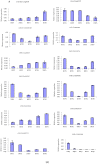Metabolome and Transcriptome Sequencing Analysis Reveals Anthocyanin Metabolism in Pink Flowers of Anthocyanin-Rich Tea (Camellia sinensis)
- PMID: 30889908
- PMCID: PMC6471635
- DOI: 10.3390/molecules24061064
Metabolome and Transcriptome Sequencing Analysis Reveals Anthocyanin Metabolism in Pink Flowers of Anthocyanin-Rich Tea (Camellia sinensis)
Abstract
Almost all flowers of the tea plant (Camellia sinensis) are white, which has caused few researchers to pay attention to anthocyanin accumulation and color changing in tea flowers. A new purple-leaf cultivar, Baitang purple tea (BTP) was discovered in the Baitang Mountains of Guangdong, whose flowers are naturally pink, and can provide an opportunity to understand anthocyanin metabolic networks and flower color development in tea flowers. In the present study, twelve anthocyanin components were identified in the pink tea flowers, namely cyanidin O-syringic acid, petunidin 3-O-glucoside, pelargonidin 3-O-beta-d-glucoside, which marks the first time these compounds have been found in the tea flowers. The presence of these anthocyanins seem most likely to be the reason for the pink coloration of the flowers. Twenty-one differentially expressed genes (DEGs) involved in anthocyanin pathway were identified using KEGG pathway functional enrichment, and ten of these DEG's screened using venn and KEGG functional enrichment analysis during five subsequent stages of flower development. By comparing DEGs and their expression levels across multiple flower development stages, we found that anthocyanin biosynthesis and accumulation in BTP flowers mainly occurred between the third and fourth stages (BTP3 to BTP4). Particularly, during the period of peak anthocyanin synthesis 17 structural genes were upregulated, and four structural genes were downregulated only. Ultimately, eight critical genes were identified using weighted gene co-expression network analysis (WGCNA), which were found to have direct impact on biosynthesis and accumulation of three flavonoid compounds, namely cyanidin 3-O-glucoside, petunidin 3-O-glucoside and epicatechin gallate. These results provide useful information about the molecular mechanisms of coloration in rare pink tea flower of anthocyanin-rich tea, enriching the gene resource and guiding further research on anthocyanin accumulation in purple tea.
Keywords: Camellia sinensis (L.); WGCNA; anthocyanin biosynthesis; anthocyanin-rich cultivar; flower development; metabolome; transcriptome.
Conflict of interest statement
The authors declare no conflict of interest.
Figures













Similar articles
-
Metabolome and Transcriptome Analysis Reveals Putative Genes Involved in Anthocyanin Accumulation and Coloration in White and Pink Tea (Camellia sinensis) Flower.Molecules. 2020 Jan 2;25(1):190. doi: 10.3390/molecules25010190. Molecules. 2020. PMID: 31906542 Free PMC article.
-
Integrative Analysis of Metabolomics and Transcriptomics Reveals Molecular Mechanisms of Anthocyanin Metabolism in the Zikui Tea Plant (Camellia sinensis cv. Zikui).Int J Mol Sci. 2022 Apr 26;23(9):4780. doi: 10.3390/ijms23094780. Int J Mol Sci. 2022. PMID: 35563169 Free PMC article.
-
The Effects of Ultraviolet A/B Treatments on Anthocyanin Accumulation and Gene Expression in Dark-Purple Tea Cultivar 'Ziyan' (Camellia sinensis).Molecules. 2020 Jan 15;25(2):354. doi: 10.3390/molecules25020354. Molecules. 2020. PMID: 31952238 Free PMC article.
-
Anthocyanin metabolism and its differential regulation in purple tea (Camellia sinensis).Plant Physiol Biochem. 2023 Aug;201:107875. doi: 10.1016/j.plaphy.2023.107875. Epub 2023 Jul 9. Plant Physiol Biochem. 2023. PMID: 37451003 Review.
-
Revolutionizing Speciality Teas: Multi-omics prospective to breed anthocyanin-rich tea.Food Res Int. 2025 May;209:116312. doi: 10.1016/j.foodres.2025.116312. Epub 2025 Mar 19. Food Res Int. 2025. PMID: 40253154 Review.
Cited by
-
Identification of HpMYB1 inducing anthocyanin accumulation in Hippeastrum Hybridum tepals by RNA-seq.BMC Plant Biol. 2023 Nov 28;23(1):594. doi: 10.1186/s12870-023-04582-4. BMC Plant Biol. 2023. PMID: 38012575 Free PMC article.
-
Comparative transcriptomic and metabolomic analysis reveals mechanisms of selenium-regulated anthocyanin synthesis in waxy maize (Zea mays L.).Front Plant Sci. 2024 Oct 3;15:1466756. doi: 10.3389/fpls.2024.1466756. eCollection 2024. Front Plant Sci. 2024. PMID: 39421142 Free PMC article.
-
Characterization of tea (Camellia sinensis L.) flower extract and insights into its antifungal susceptibilities of Aspergillus flavus.BMC Complement Med Ther. 2023 Aug 14;23(1):286. doi: 10.1186/s12906-023-04122-5. BMC Complement Med Ther. 2023. PMID: 37580785 Free PMC article.
-
Omics Analysis Unveils the Pathway Involved in the Anthocyanin Biosynthesis in Tomato Seedling and Fruits.Int J Mol Sci. 2023 May 12;24(10):8690. doi: 10.3390/ijms24108690. Int J Mol Sci. 2023. PMID: 37240046 Free PMC article.
-
Integrated Analyses of Metabolome and RNA-seq Data Revealing Flower Color Variation in Ornamental Rhododendron simsii Planchon.Genes (Basel). 2024 Aug 7;15(8):1041. doi: 10.3390/genes15081041. Genes (Basel). 2024. PMID: 39202401 Free PMC article.
References
-
- Ruxton C.H.S., Bond T.J. Fluoride content of UK retail tea: Comparisons between tea bags and infusions. Proc. Nutr. Soc. 2015:74. doi: 10.1017/S0029665115000993. - DOI
MeSH terms
Substances
Grants and funding
LinkOut - more resources
Full Text Sources

